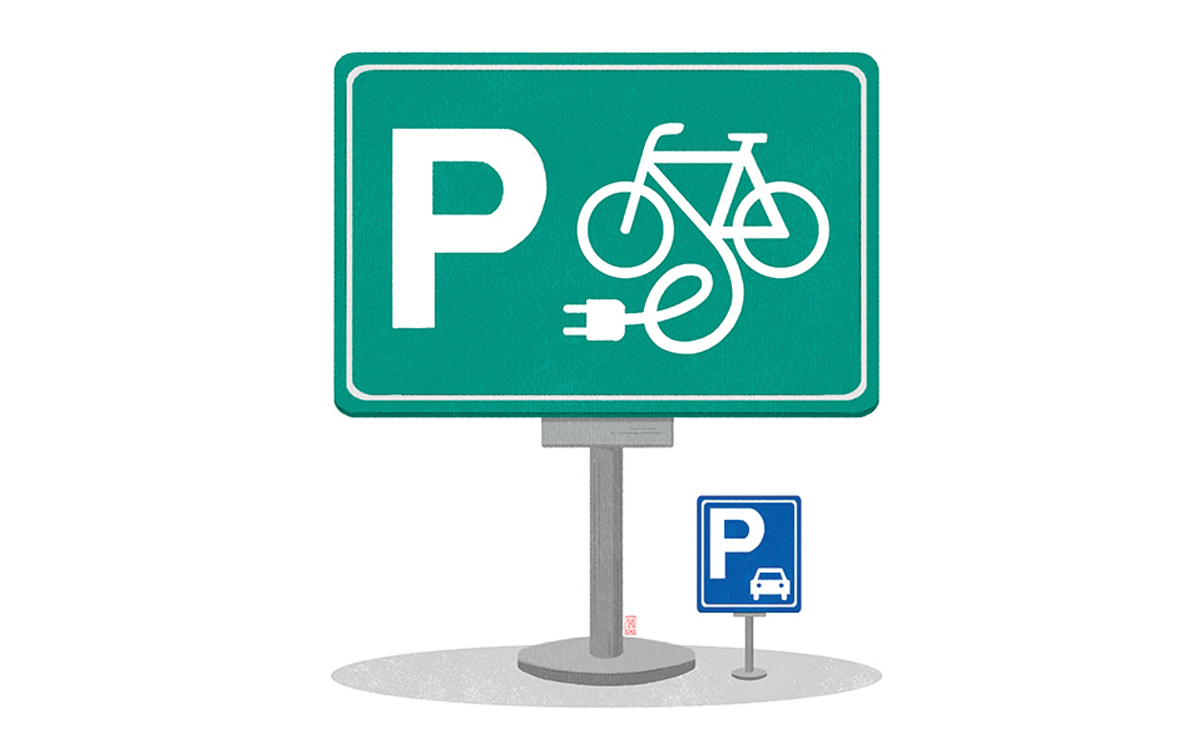Why E-Bikes Could Change Everything
Cities take on transportation’s whopping carbon footprint

As e-bike converts will attest, zooming through your neighborhood and effortlessly conquering the steepest of hills is a total blast. The added storage capacity of e-cargo bikes makes them especially viable as vehicle replacements. And at about $1,000 for a solid entry-level electric bike (high-end versions and e-cargo bikes can be much pricier), they're affordable. Best of all, using an e-bike in lieu of a car helps reduce the whopping 27 percent of US greenhouse gases that come from transportation.
Why Get an E-bike
In 2017, British researchers offered 80 people in Brighton a free e-bike for up to eight weeks. The average participant drove 20 percent fewer miles while they had an e-bike, and afterward 70 percent of them said they wanted one of their own. Even in a country as vast as the United States, almost 60 percent of car trips are under six miles—and e-bikes offer powerful advantages for daily trips. Steep inclines, for instance, become a cinch. An e-bike's extra boost lets you comfortably match the speed of car traffic while en route to a meeting—and avoid arriving in a pool of your own sweat. Particularly for those with limited mobility (like Tour de France champion Greg LeMond, who is now designing his own e-bike), the addition of battery power can be life changing.
Every trip taken by e-bike instead of automobile is a win for the planet. Even electric cars require far more resources than e-bikes to construct and operate (at 1,800 pounds, the battery of the Ford F-150 Lightning weighs as much as 233 Rad Power e-bike batteries). And according to one market estimate, e-bikes now outsell electric cars in the United States; almost 800,000 were purchased in 2021. But a look across the Atlantic shows that much room for growth remains: Germany, a country with just about a quarter of America's population, sold 1.2 million e-bikes in the first six months of last year alone.
How We Can Accelerate E-bike Adoption—and Car-Trip Replacement

Improved Bike-Lane Infrastructure
Only the bravest of cyclists are willing to share a traffic lane with cars roaring by at 40 miles per hour. Studies show that painted bike arrows on pavement—so-called sharrows—actually make injuries more likely, not less. The good news is that if cities install dedicated bike lanes, more people will consider cycling—especially if the lanes are physically protected from cars.
Last year's federal infrastructure bill set aside $6 billion to create the Safe Streets and Roads for All program, which could fund a bevy of new bike lanes. But the Feds can do only so much on their own. States, cities, and counties manage most transportation planning, so we need state and local officials to not only ensure that e-bikes are legal for all to ride (New York City has tried to crack down on delivery workers' use of e-bikes, for instance) but also incorporate new bike routes into their road redesigns. And while they're at it, state and local officials should expand commuter benefits to include perks for all bike riders. Planners should envision a complete network of safe cycling routes crisscrossing the region. Minneapolis city planners recently took a cue from Italy, where such networks are called bicipolitanas, or "bike subways."
Financing
Although an e-bike is cheaper than a new car, many people can't just drop $1,000. To the frustration of bike advocates, no federal incentives for e-bikes were included in the energy and climate legislation brokered over the summer. In the absence of a national policy, some states and cities are devising their own e-bike incentives, such as an income-based rebate of up to $1,000 that's been proposed in Connecticut and the rebate of up to $1,700 that Denver began offering to residents earlier this year. If policymakers want to think bigger, they could draw inspiration from France's "e-bike for clunkers" program, which offers up to 2,500 euros toward an e-bike purchase for those trading in a car.
Parking
Many people are understandably wary of leaving their pricey e-rides on the street. To help, cities could provide storage, along the lines of what Jersey City, New Jersey, has done by promising to build 29 bike storage facilities by the end of 2022. BikeLink has an extensive network of safe bike parking on the West Coast and is expanding. For an example of how far ahead some other countries are, see the "bicycle park" below the train station in Utrecht, the Netherlands, which can accommodate over 12,000 bikes.
Employers, too, can give e-bikes a tailwind. Businesses often offer free car parking to employees but negligible facilities for cyclists, especially those using e-cargo bikes. At a minimum, providing secure bike storage can allow commuters to consider leaving the car at home; more ambitious employers might add the option of a "parking cash-out," a financial inducement not to drive (saving the employer money on providing car parking).
Test-Drives
E-bike libraries offer people a chance to try out an e-bike without committing to buying one. Local Motion, a nonprofit organization in Vermont, runs public e-bike libraries in Burlington and Brattleboro, as well as two others that rotate around the state. Last year, officials in Oakland, California, received a $1 million state grant to launch an e-bike library program focused on low-income neighborhoods. Many cities have added electric bikes to their public bike-share fleets, including New York City, Austin, and Washington, DC, while a few, like Charlotte, North Carolina, have gone all-electric. Some e-bike subscription services, including Dance, let you rent bikes on a monthly basis.
 The Magazine of The Sierra Club
The Magazine of The Sierra Club



